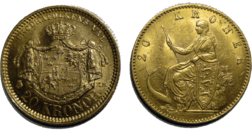Scandinavian Monetary Union
The Scandinavian Monetary Union was a monetary union formed by Denmark and the Swedish part of the Union between Sweden and Norway on 5 May 1873, by fixing their currencies against gold at par to each other. After the dissolution of the Swedish-Norwegian union, in 1905, Norway continued to be a part of this monetary union. The union ended with the outbreak of World War I.[1]
| Scandinavian Monetary Union | |
|---|---|
 Two golden 20 kr coins, with identical weight and composition. The coin to the left is Swedish and the right one is Danish. | |
| Denominations | |
| Subunit | |
| 1⁄100 | øre/öre |
| Plural | kroner/kronor |
| øre/öre | øre/öre (singular and plural) |
| Symbol | kr. |
| Coins | 1, 2, 5, 10, 25, 40, 50 øre 1, 2, 5, 10, 25 kroner |
| Demographics | |
| User(s) | |
| Issuance | |
| Central bank | Danmarks Nationalbank, Skandinaviska Banken, Norges Bank, Sveriges Riksbank |
| Valuation | |
| Pegged with | Gold standard |
This infobox shows the latest status before this currency was rendered obsolete. | |
| Part of a series on |
| Scandinavia |
|---|
|
Geography |
Norway, which was in union with Sweden, however with full inner autonomy, entered the union two years later, in 1875, by pegging its currency to gold at the same level as Denmark and Sweden, 2.48 kroner/kronor per gram of gold, or roughly 0.403 grams per krone/krona.[2] An equal valued krone/krona of the monetary union replaced the three legacy currencies at the rate of 1 krone/krona = 1⁄2 Danish rigsdaler = 1⁄4 Norwegian speciedaler = 1 Swedish riksdaler. The monetary union was one of the few tangible results of the Scandinavian political movement of the 19th century.
In the "World Currency" of its time, British pounds, 1 pound was roughly equal to 18 Kroner.[3] The ratio connecting the Scandinavian currencies to the Latin Monetary Union was 0.72 Krone for 1 French Franc.
Overview
The 1873 switch in Scandinavia from the silver to the gold standard was triggered by Germany's adoption of the gold mark in the same year and of the consequent disturbance in the silver market. The rate in which the Reichsthaler of the Hamburg Bank (The Hamburg Thaler Banco) was converted to gold marks established the gold parity of the new krone: 4 krone = 1 Norwegian speciedaler = 1 Hamburg Thaler Banco = 4.5 gold marks. One gram of fine gold worth 2.79 gold marks was therefore equivalent to 2.48 krone.
The union provided fixed exchange rates and stability in monetary terms, but the member countries continued to issue their own separate currencies. Although not initially foreseen, the perceived security led to a situation where the formally separate currencies were accepted on a basis of "as good as" the legal tender virtually throughout the entire area.
Upon acceding to the union, Sweden had the name of its currency changed from Riksdaler Riksmynt to Swedish krona. The word "krone/krona" literally means "crown", and the differences in spelling of the name represent the differences between the North Germanic languages.
The political union between Sweden and Norway was dissolved in 1905, but this did not affect the basis for co-operation in the monetary union.
All three countries still use the same currencies as during the monetary union, but they lost their peg, one to one, in 1914. The Icelandic króna is a derivative of the Danish krone, established after Iceland was elevated to a separate kingdom in union with Denmark in 1918. Iceland cut its ties to Denmark in 1944 and became a republic. The Icelandic króna soon became volatile, causing a high inflation and in 1980 a currency reform was introduced, in which 1 new Icelandic króna was set to 100 original ones.[4]
The Scandinavian Monetary Union was inspired by the Latin Monetary Union, established in 1865.[5] As Scandinavia became industrialized, a call for a firm monetary system had risen in the 1860s. The idea of using a foreign currency was discussed, but as the old dividing of the British Pound was similar to what Scandinavia wished to get rid of, the French defeat in the Franco-Prussian War made the French Franc less attractive and as the German Mark was out of the question in Denmark after the 1864 Second Schleswig War, the idea of a Scandinavian Monetary system based on the Gold standard was imposed 1873 to 1875. [6] The union was dissolved gradually from the outbreak of World War One until 1924, when the union formally was dissolved.[7] Nevertheless, the 1:1:1 banknote rate continued at least until the economical crisis in the early 1930s.[8]
Whether the Scandinavian Monetary Union was a success or not, has been a subject of discussion. While some experts means it functioned as best between 1901 and 1905 and by then was a complete system of coin, banknotes and common drawing rights that worked between the central banks. A success in its own limited monetary terms. The Union, however, was only of minor importance in the total foreign relations of the member countries. Moreover, the trade between the member countries composed only a small part of their total trade, and this part was declining during the lifetime of the Union. The monetary union was never accompanied by a tariff union as well. This stresses its partial nature - it never formed a vital part of the these countries' international economic relations.[9] Other experts gives it a little better credit, no other politically independent countries went equally far in their monetary integration. In an international perspective, it was the most successful of all monetary unions during the time of the classic gold standard.[10]
See also
Banks
- Danmarks Nationalbank
- Norges Bank
- Skandinaviska Banken
- Sveriges Riksbank
Currencies before the union
- Danish rigsdaler
- Norwegian rigsdaler
- Norwegian speciedaler
- Swedish riksdaler
Currencies during and after the union
References
- Rongved, Gjermund Forfang (2017-09-02). "The Gold War: the dissolution of the Scandinavian Currency Union during the First World War". Scandinavian Economic History Review. 65 (3): 243–262. doi:10.1080/03585522.2017.1364292. ISSN 0358-5522.
- The Danish National Bank: From silver standard to gold standard Archived 2013-11-03 at the Wayback Machine
- "Historia.se - historisk statistik på nätet". Retrieved 21 February 2019.
- "Isländsk krona - Sidor [1] - World uppslagsverk kunskap".
- BBC
- Lars Jonung (former Professor of the Swedish Trading School, Stockholm), https://www.nationalekonomi.se/filer/pdf/31-4-lj.pdf, pdf-page 2 (of 8)
- Lars Jonung, https://www.nationalekonomi.se/filer/pdf/31-4-lj.pdf, pdf-page 5 (of 8)
- "Söndagstidningen Södra Sverige", 16. December 1926, page with exchange rates
- "International Monetary Systems in Historical Perspective",Niels Kærgård and Ingrid Henriksen, 1995, publisher Palgrave Macmillan, London, ISBN 9781349242221, page 109, doi:10.1007/978-1-349-24220-7_5
- Lars Jonung, https://www.nationalekonomi.se/filer/pdf/31-4-lj.pdf, pdf-page 4 (of 8)
Further reading
- Henriksen, Ingrid, and Niels Kærgård. "The Scandinavian currency union 1875–1914." in Jaime Reis, ed., International Monetary Systems in Historical Perspective. (Palgrave Macmillan UK, 1995) pp. 91-112.
- Øksendal, Lars Fredrik. "The impact of the Scandinavian Monetary Union on financial market integration." Financial History Review 14#2 (2007): 125-148.
